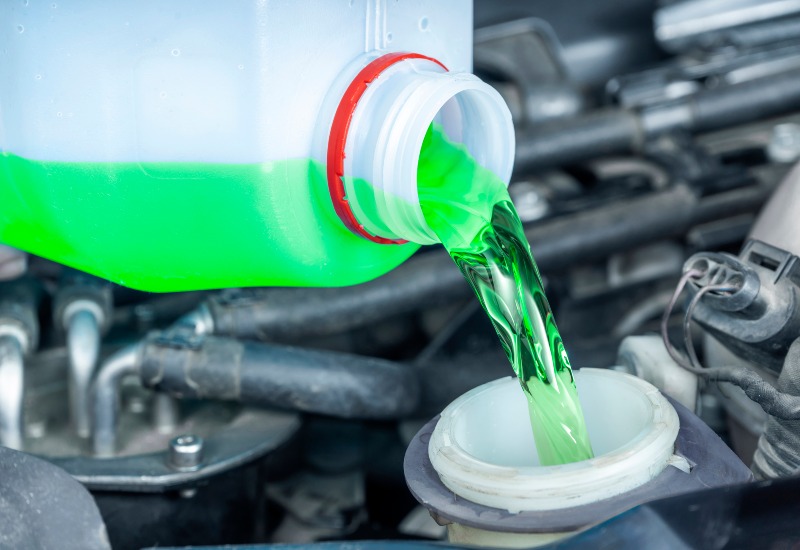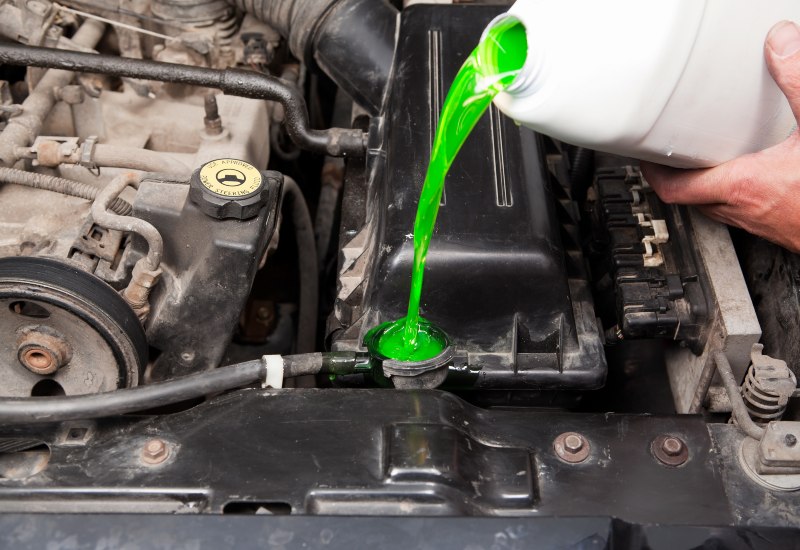Antifreeze: The Ultimate Guide
As a company focused on supplying quality fuels and lubricants for commercial partners, Red River Oil Company stresses the importance of essential fluids like antifreeze in heavy-duty diesel engines throughout TX, AR, OK, and LA. Antifreeze isn’t just about keeping engines from freezing in cold weather. It’s critical to their output and health year-round. Understanding antifreeze is key to ensuring engine efficiency, longevity, and reliability for commercial truck drivers, fleet managers, and heavy equipment operators.
What Is Antifreeze?
Vehicles rely on fluids and lubricants to run smoothly. Antifreeze, often called coolant, is a liquid added to a vehicle’s radiator that regulates engine temperature. Combustion engines create an incredible amount of heat as they run. The radiator cycles coolant around the engine block to keep it from overheating. It also protects the engine’s rubber, metal, and plastic parts by maintaining a safe operating temperature.

Why Use Antifreeze Instead of Water?
While water effectively transfers heat, it falls short in harsh environments. Since water freezes at 32°F, engines in colder climates would have hoses bursting and radiators cracking when the water freezes. Even in warmer climates, hot engines would cause water to boil at 212°F, creating steam, which puts excessive pressure on components and likely shortens their lifespan. Steam also escapes, so the radiator levels would constantly run low. Antifreeze’s glycol-based makeup lowers the freezing point of water while raising the boiling point to avoid freezing and overheating, making it effective in all temperatures and extreme conditions. It also includes rust inhibitors and other additives to provide corrosion protection.
Antifreeze vs. Coolant: Are They the Same?
Understanding the difference between antifreeze and coolant is essential because adding the wrong fluid can damage your engine. Antifreeze is a concentrated liquid that must be mixed with water before adding it to your engine. Coolant is a premixed solution of antifreeze and water ready for use from the container. While the terms are often used interchangeably, understanding the distinction can help you choose the right product for your specific needs. Read labels carefully, as the container will specify if it’s antifreeze or coolant.
Types of Heavy-Duty Diesel Antifreeze
There are four main antifreeze types, each suited to specific engines and operating conditions. Here’s a breakdown of what you need to know for heavy-duty diesel truck engines.
Inorganic Acid Technology (IAT)
- Composition – Traditional antifreeze containing silicate-based additives.
- Benefits – Provides effective, immediate protection against corrosion.
- Ideal Use – Best for older heavy-duty diesel engines but requires frequent replacement, usually every two years.
- Special Note – IATs require a Supplemental Coolant Additive (SCA) to be added at the first 25,000-mile interval because the original additives will be used up by then.

Hybrid Organic Acid Technology (HOAT)
- Composition – Combines the benefits of traditional silicate-based inhibitors with long-lasting organic acid technology.
- Benefits – Offers extended protection, typically up to five years, against corrosion and scaling.
- Ideal Use – Suitable for a wide range of heavy-duty applications, including mixed fleets.
- Special Note – They offer longer protection than IATs but still require SCAs at 25,000-mile intervals.
Nitric Organic Acid Technology (NOAT)
- Composition – Organic acid with added nitrites for enhanced protection.
- Benefits – Prevents cavitation and corrosion in high-pressure diesel engines.
- Ideal Use – Designed for heavy-duty diesel engines operating under extreme conditions, such as long-haul trucks. No chemical additives are required for up to 300,000 miles.
Organic Acid Technology (OAT)
- Composition – Silicate-free and phosphate-free organic acid formulation.
- Benefits – Designed for extended life, up to six years or 600,000 miles, and optimized for modern engine materials.
- Ideal Use – Commonly used in newer heavy-duty diesel trucks with advanced engines.
Selecting the Right Antifreeze
In the same way your truck requires a specific type of fuel, it will use a particular type of antifreeze. Here are a few things to consider when choosing antifreeze for your diesel engine:
- Engine Compatibility – Check your engine manufacturer’s recommendations—different engines may require specific antifreeze formulations.
- Operating Conditions – Consider your typical driving environment. Vehicles operating in harsh weather or carrying heavy loads often need higher-grade antifreeze.
- Maintenance Intervals – Pick a type of antifreeze that matches your maintenance schedule to ensure optimal performance.
Maintenance Tips: How Often Should Antifreeze Be Changed?
Changing your antifreeze at regular intervals is vital for engine health. Remember to check your antifreeze levels and quality regularly. Look out for signs of degradation, such as discoloration or a lack of freezing/boiling point control. Refer to your vehicle manufacturer’s recommendations for coolant replacement intervals. A general guideline based on type is:
- IAT Antifreeze – Change every 2 years or 30,000 miles.
- HOAT Antifreeze – Change every 5 years or 50,000 miles.
- NOAT/OAT Antifreeze – Can last up to 6 years or 600,000 miles in heavy-duty diesel trucks.
Red River Oil Company Is Here to Help
Red River Oil Company knows that keeping your fleet running at peak performance is your top priority. We provide high-quality, heavy-duty truck antifreeze and professional-grade solutions for businesses in Texas, Arkansas, Oklahoma & Louisiana designed to protect your engines and extend their lifespan. Paired with our reliable commercial fuel delivery services, we’re committed to being the partner you can depend on to keep your heavy-duty vehicles and fleet trucks on the road or in the field. Contact us today to learn more about our antifreeze offerings and how we can help support your business.
